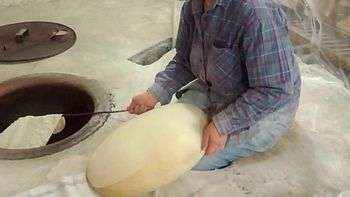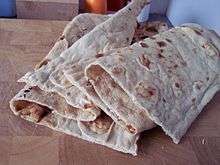Lavash
| Lavash | |
|---|---|
|
Different varieties of Lavash sold in Yerevan | |
| Country | Armenia |
| Domains | Food |
| Reference | 985 |
| Region | Europe and North America |
| Inscription history | |
| Inscription | 2014 (9th session) |
Lavash (Armenian: լավաշ; Azerbaijani and Turkish: lavaş; Kurdish: nanê loş; Persian: لواش; Georgian: ლავაში), sometimes referred to as Armenian lavash,[note 1][7][8] is a soft, thin unleavened flatbread[9] made in a tandoor (called tonir in Armenian) and eaten all over the Caucasus, Western Asia and the areas surrounding the Caspian Sea.[10][11][12] Lavash is the most widespread type of bread in Armenia, Azerbaijan, Turkey and Iran.[13]
In 2014, "lavash, the preparation, meaning and appearance of traditional bread as an expression of culture in Armenia" was inscribed in the UNESCO Representative List of the Intangible Cultural Heritage of Humanity.[14] In 2016, making and sharing flatbread (lavash, katyrma, jupka or yufka) in communities of Azerbaijan, Iran, Kazakhstan, Kyrgyzstan and Turkey was inscribed on the list as well.[15]
History
Most modern food specialists claim that it originated in Armenia,[16][17][18] whilst others state that it probably originated in Middle East.[19] According to Peter Reinhart, "Lavash, though usually called Armenian flatbread, also has Iranian roots and is now eaten throughout the Middle East and around the world".[20]
Etymology
Hrach Martirosyan tentatively connects Armenian լավաշ lavaš with dialectal լափ lapʿ, լուփ lupʿ, լովազ lovaz ‘palm, flat of the hand’, լափուկ lapʿuk, լեփուկ lepʿuk ‘flat, polished stone for playing’, լավազ lavaz ‘very thin’ and assumes derivation from Proto-Armenian *law- ‘flat’. He remarks that semantically this is conceivable since this bread is specifically flat and thin. He then proceeds:[21]
- If this interpretation is correct, the Armenian should be regarded as the source of the others. This is probable since, as Adjarian (HAB 2: 308a)[22] informs, *lavaš is considered to be Armenian bread in both Yerevan and Iran (being opposed with sangak for Turks and Persians), and in Tehran this bread is called nūn-i armanī ‘Armenian bread’. Similar data can be found also for other regions. In Dersim, for instance, lavaš is seen as characteristic for Armenian hospitality whereas the Kurdish entertain with sači hacʿ [Halaǰyan 1973: 294b].
Preparation

Lavash is made with flour, water, and salt. The thickness of the bread varies depending on how thin it was rolled out. Toasted sesame seeds and/or poppy seeds are sometimes sprinkled on before baking.
Traditionally the dough is rolled out flat and slapped against the hot walls of a clay oven. While quite flexible when fresh, lavash dries out quickly and becomes brittle and hard. The soft form is easier to use when making wrap sandwiches; however, the dry form can be used for long-term storage (almost one year) and is used instead of leavened bread in Eucharist traditions by the Armenian Apostolic Church. In Armenian villages, the dried lavash is stacked high in layers to be used later, and when the time comes to rehydrate the bread, it is sprinkled with water to make it softer again. In its dry form, left-over lavash is used in Iran to make quick meals after being rehydrated with water, butter and cheese. In Armenia the dried bread is broken up into khash. In Armenia fresh lavash is used to wrap Khorovats and to make wraps with herbs and cheese. In Iran, Turkey and middle-east lavash is used with kebabs to make dürüm wraps. According to the Encyclopedia International, "Common to all Armenians is their traditional unleavened bread, lavash, which is a staple in the Armenian diet."[23]
In art
Women baking lavash is a common theme that has inspired Armenian painters. One such portrait by the famous Soviet-era painter Minas Minassian is displayed at the National Museum of Art in Yerevan. A print of the painting Armenian Ladies Baking Lavash by Armenian American artist Manuel Tolegian was selected by U.S. President Gerald Ford to hang in the White House Bicentennial Collection. The weekend open-air arts-and-crafts market in downtown Yerevan offers many lavash-related paintings and handiworks, with renditions of happy women making lavash having become a common sight.[24]
See also
- Matnakash, a traditional leavened Armenian bread
- Markook, an unleavened flatbread common in the Levant, made on a saj
- Chapati, an unleavened South Asian flatbread, made on a tava (or saj)
- Tandyr nan (ru), a Central Asian leavened bread made in a tandoor
- Sangak, a type of leavened Iranian flatbread, made in an oven
- Barbari bread, a popular type of Iranian bread
- Taftan, a thicker leavened Iranian bread
- Lavaş cheese
- Tandoor
References
- ↑ Most sources claim that it is of Armenian origin,[1][2][3] including the The American Heritage Dictionary of the English Language.[4][5] The Encyclopedia of Jewish Food states that its origin is Middle East.[6]
- ↑ Albala, Ken. Food Cultures of the World Encyclopedia, Volume 1. Santa Barbara, Calif.: Greenwood. p. 5. ISBN 9780313376269.
- ↑ Khanam, R. (2005). Encycl. Ethnography Of Middle-East And Central Asia (3 Vols. Set) (1st ed.). New Delhi: Global Vision. p. 55. ISBN 9788182200623.
- ↑ Goldstein, Darra (1999). A Taste of Russia: A Cookbook of Russian Hospitality (2nd ed.). Montpelier, VT: Russian Life Books. p. 185. ISBN 9781880100424.
- ↑ Provided by wordnik.com website
- ↑ Provided by Yahoo Education website
- ↑ Gil Marks (2010). Encyclopedia of Jewish Food. John Wiley and Sons. p. 355.
- ↑ Goldstein, Darra (1999). A Taste of Russia: A Cookbook of Russian Hospitality (2nd ed.). Montpelier, VT: Russian Life Books. p. 185. ISBN 9781880100424.
Armenian Flat Bread Lavash: Lavash has been baked for centuries in Armenia.
- ↑ Khanam, R. (2005). Encycl. Ethnography Of Middle-East And Central Asia (3 Vols. Set) (1st ed.). New Delhi: Global Vision. p. 55. ISBN 9788182200623.
The t'onir is a round hole dug in the ground, which can be used for baking Armenian flat bread (lavash) and for heating the home in winter.
- ↑ Compare: Kipfer, Barbara Ann (2012). The Culinarian: A Kitchen Desk Reference. Houghton Mifflin Harcourt. p. 334. ISBN 9780544186033. Retrieved 2015-06-01.
LAVASH, LAVOSH, LAHVOSH, LAWAASH, or LAWASHA, also called ARMENIAN CRACKER BREAD, CRACKER BREAD, or PARAKI, is a round, thin Middle Eastern bread that is soft like a tortilla or hard like a cracker.
- ↑ Alan Davidson (1999). The Oxford Companion to Food. Oxford University Press. p. 456. ISBN 978-0192806819.
Lavash a thin crisp bread usually made with wheat flour made in a variety of shapes all over the regions of the Caucasus, Iran (where it is often so thin as to be like tissue and can be almost seen through), and Afghanistan. It is leavened and baked in a tandoor. Lavash is served with kebabs and is used to scoop up food or wrap round food before being eaten. The Turkish yufka is similar, but is unleavened and cooked on a griddle, called a saj. Its origins are ancient and it is also known as lavaş depending on the region. As in the other countries of this region large batches of this bread are made and stored for long periods. In Turkey they are stored on a board suspended by all four corners from the ceiling. The bread becomes dry and is restored by sprinkling with water and reheated as and when needed. Yufka is also used in the same way as filo pastry to encase various fillings.
- ↑ Chattman, Lauren (2011). Bread Making: A Home Course: Crafting the Perfect Loaf, From Crust to Crumb. Storey Publishing. p. 202. ISBN 978-1603427005.
Lavash is a thin, yeast-raised flatbread that originated in Armenia and is now popular in a much wider area that includes Turkey, Georgia, and Iran.
- ↑ Morgan, Diane (2010). Skinny Dips. Chronicle Books. p. 14. ISBN 978-1452100241.
Lavash, lavosh, or lahvosh is a gigantic, paper-thin, blistery, tortilla-like flatbread common throughout Armenia, Turkey, and Iran.
- ↑ The Bread Baker's Apprentice: Making Classic Breads with the Cutting-edge Techniques of a Bread Master
- ↑ "Lavash, the preparation, meaning and appearance of traditional bread as an expression of culture in Armenia, Inscribed in 2014 (9.COM) on the Representative List of the Intangible Cultural Heritage of Humanity. Country(ies): Armenia". unesco.org. Retrieved 16 March 2016.
- ↑ "Flatbread making and sharing culture: Lavash, Katyrma, Jupka, Yufka". unesco.org. Retrieved 1 December 2016.
- ↑ Sergio O. Serna-Saldivar (2012). Cereal Grains: Laboratory Reference and Procedures Manual. CRC Press. p. 217. ISBN 9781439855652.
Lavash is another popular flat cracker bread with ancient roots in Armenia.
- ↑ Albala, Ken (ed.). Food Cultures of the World Encyclopedia, Volume 1. Santa Barbara, Calif.: Greenwood. p. 5. ISBN 9780313376269.
...on lavash, a traditional flatbread of Armenia similar to tortilla...
- ↑ Chattman, Lauren (2011). Bread Making: A Home Course: Crafting the Perfect Loaf, From Crust to Crumb. Storey Publishing. p. 202. ISBN 978-1603427005.
Lavash is a thin, yeast-raised flatbread that originated in Armenia and is now popular in a much wider area that includes Turkey, Georgia, and Iran.
- ↑ Marks, Gil (2010). Encyclopedia of Jewish Food. Houghton Mifflin Harcourt. p. 355. ISBN 978-0470391303.
- ↑ Reinhart, Peter (2011). The Bread Baker's Apprentice: Mastering the Art of Extraordinary Bread. Potter/TenSpeed/Harmony. p. 178. ISBN 978-1607741299.
Lavash, though usually called Armenian flatbread, also has Iranian roots (...)
- ↑ Martirosyan, Hrach (2010). Etymological Dictionary of the Armenian Inherited Lexicon. Brill Academic Publishers. p. 305. ISBN 9789004173378.
- ↑ Adjarian, Hrachia. Hayerēn armatakan baṙaran [Dictionary of Armenian Root Words] (in Armenian). II. Yerevan: Yerevan State University. p. 308.
- ↑ Encyclopedia international, Volume 2. Lexicon Publications. 1980. p. 39.
- ↑ Irina Petrosian, David Underwood (2006). Armenian Food: Fact, Fiction & Folklore. Yerkir Publishing. pp. 26, 27. ISBN 978-1-4116-9865-9.
Women baking lavash is a theme that has always inspired Armenian painters. One such portrait by the famous Soviet-era painter Minas Minassian is displayed at the National Museum of Art in Yerevan. A print of the painting "Armenian Ladies Baking Lavash" by Manuel Tolegian, an American artist of Armenian origin, was selected by US President Gerald Ford to hang in the White House Bicentennial Collection. The weekend open-air arts-and-crafts market in downtown Yerevan now offers countless lavash-related paintings and handiworks. These many renditions of happy women making lavash have almost becomes a tired cliché.
External links
| Wikimedia Commons has media related to Lavash. |
| Look up lavash in Wiktionary, the free dictionary. |
- Lavash in Dictionary.com
- International Journal of Food Science and Technology Vol. 40, No. 4, pp. 469-479.
